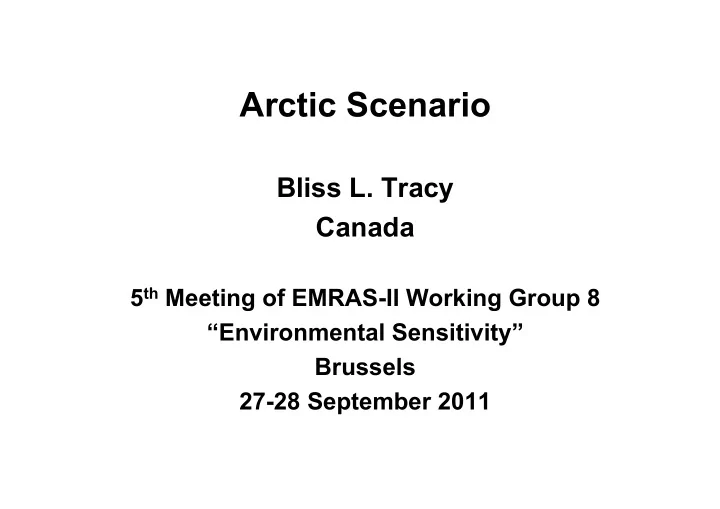

Arctic Scenario Bliss L. Tracy Canada 5 th Meeting of EMRAS-II Working Group 8 “Environmental Sensitivity” Brussels 27-28 September 2011
Arctic scenario -- Cs-137 adult doses 1.00E+00 1.00E-01 Dose (mSv/year) 1.00E-02 1.00E-03 1.00E-04 1.00E-05 Generic fruits and Caribou Moose Total Dose vegetables
Lichen Caribou Pathway Long range transport Radionuclide Deposition source Humans Caribou or Lichens reindeer Wolves, etc.
1. Uptake by Lichens Lichen concentration (Bq/kg dw) = Deposition (Bq/m 2 ) x transfer factor (m 2 /kg) Cs-137 deposition = 1000 Bq/m 2 Transfer factor = 1.0 m 2 /kg dw Lichen concentration = 1000 Bq/kg
2. Uptake by Caribou or Reindeer Concentration in meat (Bq/kg) = Concentration in lichens (Bq/kg dw) x lichen forage rate (kg dw/day) x absorption factor in the animal (dimensionless) x biological halftime in animal (days) /{ln(2) x mass of animal (kg)}
Lichen forage rate = 2.5 kg/d (range = 2 – 5) Absorption factor = 0.65 (range = 0.25 – 0.65) Half-time in the animal = 20d (range =10-35) Mass of animal = 80 kg Concentration in meat = 586 Bq/kg
As a reality check, we note that measurements in Finnish reindeer herds (TRS472, page 362) taken during the winter following the Chernobyl accident (when lichen feeding would have been greatest) showed aggregated transfer coefficients for 137 Cs reindeer of 0.15 to 0.84 m 2 /kg, with a geometric mean of 0.46 m 2 /kg. If this value is applied to our given deposition of 1000 Bq/m2, then the concentration in reindeer meat would be 460 Bq/kg , close to our model estimate above.
3. Dose to Humans Adult dose (mSv/year) = Concentration in meat (Bq/kg)x human consumption rate (kg/year) ingestion dose coefficient (mSv/Bq) Consumption rate = 23.7 kg/year (Baker Lake, males, 1989-90) Dose coefficient = 1.3 x 10 -5 mSv/Bq (ICRP-72) Dose = 0.181 mSv during year following deposition
Assumptions • The deposition occurs in late winter or early spring when caribou are still feeding on lichens • By the time of harvest, the caribou have been feeding long enough (several half-times) for their body burdens to reach equilibrium. • These concentrations are maintained in the animals for the entire year. This would be true if the caribou meat from a good harvest were frozen and consumed over an entire year .
Cs-137 adult doses from various pathways Caribou 0.181 Moose 0.0016 ( aggregate transfer ) Fruit & berries 0.0021 ( aggregate transfer )
Forest scenario -- Cs-137 doses (Bliss Tracy & Lauren Bergman, Health Canada) 1.00E+00 2-10 year 1.00E-01 11-20 year 21-40 year 1.00E-02 Dose (mSv/year) 1.00E-03 1.00E-04 1.00E-05 1.00E-06 Caribou Moose Small Ground Waterfowl Berries Total Dose mammals birds
Adult dose during first year ( μ Sv/year) Environment Cs ‐ 137 Sr ‐ 90 I ‐ 131 Agricultural (CHERPAC) 1931 288 467 Agricultural (RODOS) 148 161 42 Arctic (Health Canada) 2050 1010 2.6 Forest (Health Canada) 31 3 0.09 Forest (CHERPAC) 23 0.50 0.51 Freshwater Heimdalsvatn 2.9 (1.6)† 420 (0.67) ‐‐‐‐‐‐‐ Freshwater Bracciano 2 (0.12) 150 (0.025) ‐‐‐‐‐‐‐ Marine coastal (Ob Bay) 2.86 0.51 10 † numbers in brackets do not allow for irrigation of agricultural land
Animal product showing highest concentration Environment Cs ‐ 137 Sr ‐ 90 I ‐ 131 Agricultural (CHERPAC) beef milk ‐‐‐‐ Agricultural (RODOS) lamb milk milk Arctic (Health Canada) caribou ‐‐‐‐ ‐‐‐‐ Forest (HC terrestrial) caribou moose Forest (CHERPAC) fish fish fish Freshwater Heimdals fish fish ‐‐‐‐ Freshwater Bracciano fish fish ‐‐‐‐ Marine coastal fish fish sea weed
Recommend
More recommend